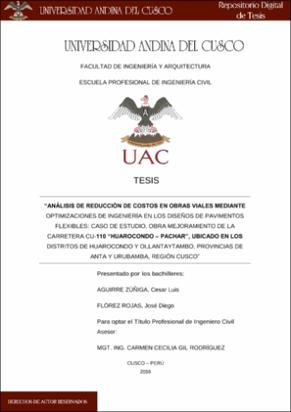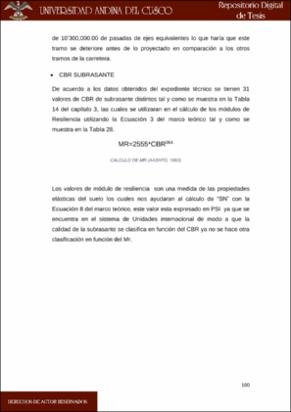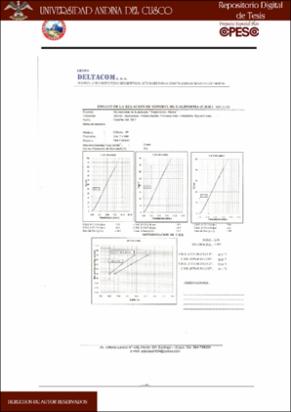| dc.contributor.advisor | Gil Rodríguez, Carmen Cecilia | |
| dc.contributor.author | Aguirre Zúñiga, Cesar Luis | |
| dc.contributor.author | Flórez Rojas, José Diego | |
| dc.date.accessioned | 2017-05-15T19:49:39Z | |
| dc.date.available | 2017-05-15T19:49:39Z | |
| dc.date.issued | 2016-12-19 | |
| dc.identifier.uri | https://hdl.handle.net/20.500.12557/706 | |
| dc.description.abstract | El presente trabajo analiza el uso de geomallas (tipo de geosintéticos), como refuerzo de bases granulares dentro de la estructura de pavimento flexible. De esta manera busca determinar si son una alternativa viable para la reducción de costos frente a un diseño pavimentos flexibles convencional, manteniendo las propiedades estructurales planteados en el diseño inicial, Con este propósito se realizaron 2 alternativas de diseño bajo los mismos parámetros del
diseño inicial plasmados en el Expediente Técnico Aprobado: la primera alternativa es un diseño convencional o no reforzado conformado por 3 capas (Base, Subbase y Carpeta Asfáltica); mientras que la siguiente alternativa de diseño consisten en el refuerzo de la capa de base con geomallas biaxiales, en
ambos casos se omite la construcción de la capa de mejoramiento de subrasante debido a que los CBR característicos de cada tramo son mayores a
6%.
Los diseños alternativos propuestos nos obligan a conocer las propiedades de
Las geomallas, por eso se hizo una recopilación de la clasificación de las mismas y se mostraron sus aplicaciones típicas. También se muestran los mecanismos de refuerzo y los beneficios varios derivados del uso de geomallas
dentro de las estructuras de pavimento.
Con esta información como base se procedió a elaborar al diseño de las estructuras de pavimentos para 31 diferentes secciones subdivididas en función a su CBR. Esto permitió hacer un análisis más completo de los diferentes factores que influyen en el resultado final obtenido con el uso de las
Geomallas como refuerzo de bases granulares; y encontrar las condiciones en
donde esta alternativa da un mejor resultado de costo-beneficio para el proyecto en análisis. Por último, se hace la recopilación de un modelo de especificación técnica, elaborada en función a los lineamientos de las especificaciones generales presentadas por el MTC (MINISTERIO DE TRANSPORTES Y COMUNICACIONES), que puede servir para su inclusión dentro de los procesos constructivos de otros proyectos a nivel nacional. | es_PE |
| dc.description.abstract | This investigation analyzes the use of geosynthetics, specifically geogrids as reinforcement for granular bases within the structure of flexible pavement. In this way it seeks to determinate whether they are an economically and viable alternative maintaining the capacity of the proposed project. For this purpose two design alternatives under the same parameters of the initial design embodied in the Approved Technical File were made: the first alternative is a conventional design of a flexible pavement with 3 layers (Base, Subbase and Folder Asphalt); while the next alternative design consist strengthening the base
layer with biaxial geogrids, in both cases the construction of the enhancement layer of subgrade is omitted because the characteristic CBR of each section are
greater than 6%.
Then for the alternative designs it is necessary to know the properties of geogrids, so a classification of these and their typical applications are shown.
Strengthening mechanisms related to the use of geogrids in pavement structures and benefits of its application they were also described.
Design methodologies that were used for this case and the investigations that led to obtain the factors involved in the design of geogrid reinforced sections were collected.
With this information as a basis we proceeded to design pavement structures for 31 different sections subdivided based on their CBR. This allowed us a more
complete analysis of the different factors that influence the final result obtained
with the use of geogrids as reinforcement of granular bases; and find the conditions in which this alternative gives a better result of cost analysis for the project. Finally, the compilation of a technical specification model, developed according to the guidelines of the general specifications submitted by the MTC (MINISTRY OF TRANSPORT AND COMMUNICATIONS), which can serve for inclusion within the construction processes of other projects nationwide. | en_US |
| dc.description.uri | Tesis | es_PE |
| dc.format | application/pdf | es_PE |
| dc.language.iso | spa | es_PE |
| dc.publisher | Universidad Andina del Cusco | es_PE |
| dc.rights | info:eu-repo/semantics/openAccess | es_PE |
| dc.rights.uri | https://creativecommons.org/licenses/by-nc-nd/2.5/pe/ | es_PE |
| dc.source | Universidad Andina del Cusco | es_PE |
| dc.source | Repositorio Institucional - UAC | es_PE |
| dc.subject | Geomallas | es_PE |
| dc.subject | Pavimento | es_PE |
| dc.subject | Estructura | es_PE |
| dc.subject | Reforzamiento | es_PE |
| dc.title | Análisis de reducción de costos en obras viales mediante optimizaciones de ingeniería en los diseños de pavimentos flexibles: caso de estudio, obra mejoramiento de la carretera CU-110 "Huarocondo-Pachar", ubicado en los distritos de Huarocondo y Ollantaytambo, provincias de Anta y Urubamba, región Cusco. | es_PE |
| dc.type | info:eu-repo/semantics/bachelorThesis | es_PE |
| thesis.degree.name | Ingeniero Civil | es_PE |
| thesis.degree.grantor | Universidad Andina del Cusco. Facultad de Ingeniería y Arquitectura | es_PE |
| thesis.degree.level | Titulo Profesional | es_PE |
| thesis.degree.discipline | Ingeniería Civil | es_PE |




